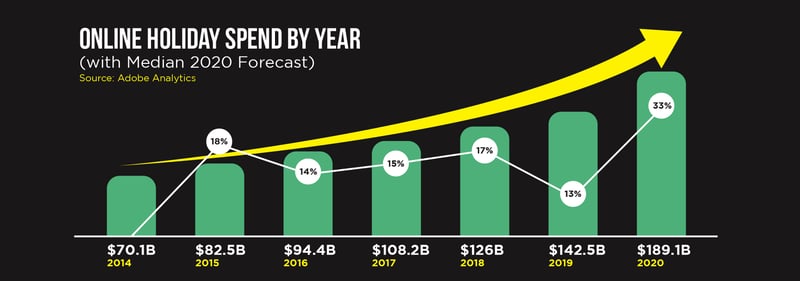The online shopping trend driven by COVID-19 is only expected to continue this year. In
2020, online retailers saw two years’ worth of expected growth in just one season.
According to Adobe Analytics, holiday e-commerce sales increased 32% from 2019 to reach$188.2 billion globally in 2020.

That’s great news for your e-commerce business, right?
But with an increasing volume of sales comes an increasing need to temporarily scale your customer service team. And that’s exactly why we’re here today.
In this guide, we’ll show you how to get through the busiest time of year without lowering service quality or breaking the bank. We’ll cover crucial topics like:
After reading this guide, you’ll be well on your way to building an effective scaling plan for the holidays.
Any time you’re considering how to approach a big project, it’s often helpful to start by asking one question: Why?
Why is it so important to plan your support for the holiday season ahead of time? If you need convincing, here are several compelling reasons
Tech and Software as a Service (SaaS) companies have convinced many people that an iterative approach to business is the best approach: ship your product, learn, tweak it, ship again...it’s a cycle that results in quick learning and avoids incorrect assumptions.
However, providing holiday customer support is not an area where this approach tends to work. It’s unwise to put yourself in a position where you have to find ways to deal with holiday volume while dealing with the volume. In particular, you need time to hire and train any new customer service agents you want to add to the team.
Putting off seasonal planning until your increased holiday volume is upon you is like forcing yourself to swim upstream - it’s incredibly difficult to make any progress
The increased volume of the holiday season that most e-commerce businesses see doesn’t just mean you’ll regret procrastinating. Viewed from
another angle, your holiday volume also means that this is one of your biggest opportunities to impress your customers.
The online shopping trend driven by COVID-19 is only expected to continue this year. In 2020, online retailers saw two years’ worth of expected growth in just one season. According to Adobe Analytics, holiday ecommerce sales increased 32% from 2019 to reach $188.2 billion globally in 2020

With more people shopping online, more of your competitors have also moved online. With the focus on e-commerce, many retailers have
invested in the online experience. Ad costs have spiked, driven by wholesalers like Costco and Walmart that haven’t traditionally competed in the online arena. Statista estimates that online shopping app customer acquisition costs have risen to over $30 USD per customer. That means that businesses must dedicate time to retaining customers for longer. Competing on customer experience is the only way to attract customers and keep them around. Your best bet to take advantage of this massive opportunity is to devote time to building out a strategic plan on how you will support these customers.
Later in this e-book, we’ll discuss specific high-impact tools and strategies to help you deliver great customer support during a busy holiday season. For now, let’s just note that many of these game-changing tactics - such as self-service options, improved delivery notices, and outsourced support - typically require a significant investment of time, money, or forethought.
By deciding where you’ll make an investment now, your entire support team will be better positioned when the holidays roll around.
Now that we’ve laid a foundation for why early planning for scaling your holiday support matters, let’s switch gears and look into how you can accomplish this.
Although the entire e-commerce segment sees major increases in volume over the holidays, it’s probably obvious that every unique organization will experience the impact slightly differently. One thing that’s true at every organization, though, is that the core of any excellent customer service strategy is your customer support team. Before you can determine exactly what that team should look like for the upcoming holiday season, you’ll need to do some work to understand what your holiday season
is going to look like.
Below are a number of specific steps you can take to gain the necessary insight into what your holiday season is likely to look like. Once digested, this data can then be put to use in developing staffing projections and building out the support team you
need.
Customers love holiday promotions, and it’s likely your sales and marketing teams have some planned for the holiday season. These promotions have the potential to draw significant increases in customers, which often means significant increases in volume for your support team. A great first step towards scaling your holiday support is working with these other teams to understand the factors that will drive holiday support volume.
When considering sales projections, note that it’s critical to look beyond projecting the dollars your customers will spend. The projected number of orders or projected number of customers can give you another perspective on the potential impact on your support team.
To accurately project how many support agents you’ll need this holiday season, you’ll need to do a bit of looking backward. There are a number of different metrics you could potentially use
to predict support ticket growth, including:
You can check out this section of our e-book on scaling customer service teams to explore why each of these metrics matters in more depth. For now, know that what you’re looking for is the different ways to connect sales volume and support. In a perfect world, you’d be able to calculate each of the metrics above and identify which one is the most consistent over time. This metric is then what you can use to forecast holiday support volume.
Let’s consider an example:
This is a very straightforward example, but it gives you a good starting line. Based upon historical data, you know you’ll likely see an additional 1200 tickets this holiday season. From
there, you can begin to estimate how many agents you’ll need to handle those tickets.

A queuing model is a tool to help you understand when your tickets come in. You might know you’ll have 1200 extra tickets over the holidays, but it’s going to be tough to staff appropriately if you don’t know what time of day or week they’re likely to come in. If you lack this info, you’ll have a hard time hitting any goals or SLAs your organization may have.
Queuing models can quickly grow complex, so we’ve put together a video where you can see exactly how a queuing model works. In a nutshell, a queuing model ingests four main data points:
These four data points are entered into a formula that outputs the expected number of agents you’ll need during each interval to achieve your goals and service levels.

While the above three steps will build out the core of your holiday staffing projection, there are a few other factors that could impact your staffing and need to be taken into account:
If you’ve taken the time to work through the items above, then hopefully you now have a general idea of how much additional support you’ll need for the holiday season. That’s huge — and that means that now it’s decision time.
The first major decision you need to make is whether you should hire internally or whether you should bring on a customer service outsourcing company. This can be a complicated decision. While you’re the only one who can know for sure what the best approach is for your e-commerce company, there are pros and cons to both.
Most people are familiar with internal support teams. They work for you directly and you’re responsible for their pay, benefits, training, engagement and more. Because this setup is very familiar, we aren’t going to spend much time discussing it.
Many people are not quite as familiar with outsourced support teams, but there are a number of great reasons to consider hiring outsourced support for your organization, particularly when you’re expecting a busy holiday season. Chief among these are:
If you decide to hire a seasonal team, you’ve got a number of decisions to make. It may seem like a given, but the most critical choice is this: What are you asking them to do?
The answer to this question will influence each of the questions below. If you’re hiring seasonal help, it’s often a good idea to have them solely focused on tier one questions, which tend to be relatively simple. If you decide to go a different route, you’ll need to adjust your training and onboarding accordingly.
Here are some important questions to ask that will help ensure clear expectations for everyone involved (yourself included!):
Once you’ve answered these questions, you can draft a timeline that will help make sure you’re on track. A sample timeline might look like the one below.
As mentioned above, growing your support team is only one way that e-commerce businesses should be preparing for the holiday rush. Implementing process improvements is a great way to both reduce ticket volume and improve your customer experience before the holiday season.
There are a number of different ways you can achieve these two goals. We’ve highlighted two different categories and some specific examples below, but remember that you should use these to spark creative ideas based upon your knowledge of your unique business.
Spending some quality time reviewing your most common tickets can be a very eye-opening experience. You’ll walk away with plenty of ideas on how to eliminate the need for customers to contact your team. For e-commerce companies, some examples include:
If there is an unavoidable need for the customer to contact your support team, then you need to find ways for your team to assist them quickly and effectively. Several examples of how to achieve this include things like:
As you’re working through the options, remember that process improvements can require a fair amount of time and energy, particularly from your senior agents and leads. Make sure you’re building these realities into your timeline and staffing projections!
It is often said you shouldn't make assumptions in your life. Unfortunately, planning your support for the holiday seasons necessitates making certain assumptions. Even when you’re using accurate data, volume and staffing projections are never guaranteed.
Because of this reality, you should make sure you’re always monitoring your staffing model to make sure you haven’t missed anything. If you see your ticket volume begin to veer away from your projection, it’s time to dive deep into your recent data to look for discrepancies. Once you’ve found out what you’ve missed, make adjustments and continue monitoring as you move forward.
The holiday season is a huge opportunity for every e-commerce company. When a new customer is introduced to your brand, you don’t just want a single sale. You want to seize the opportunity to win a loyal, recurring customer who will keep coming back.
If you want to achieve that goal, you need a solid plan to support your customers.
This e-book has covered the foundational topics you need to accomplish this: developing staffing projects, creating a hiring plan and finding ways to reduce unnecessary ticket volume.
In short, now is the time to start planning for an unbelievable holiday season. Click here to take the first step and get expert help from Peak Support today.